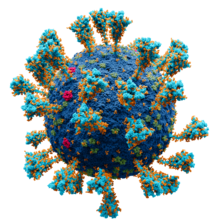
Back البروتين الشوكي لفيروس كورونا Arabic Glicoproteïna d'espícula (coronavius) Catalan Spike-Glykoprotein von SARS-CoV-2 German Proteína de la espícula (coronavirus) Spanish پروتئین اسپایک کروناویروس Persian 코로나바이러스 스파이크단백질 Korean 冠状病毒刺突蛋白 Chinese
| Coronavirus spike glycoprotein | |||||||||
|---|---|---|---|---|---|---|---|---|---|
 Model of the external structure of the SARS-CoV-2 virion.[1]
● Blue: envelope ● Turquoise: spike glycoprotein (S) ● Red: envelope proteins (E) ● Green: membrane proteins (M) ● Orange: glycan | |||||||||
| Identifiers | |||||||||
| Symbol | CoV_S1 | ||||||||
| Pfam | PF01600 | ||||||||
| InterPro | IPR002551 | ||||||||
| |||||||||
Spike (S) glycoprotein (sometimes also called spike protein,[2] formerly known as E2[3]) is the largest of the four major structural proteins found in coronaviruses.[4] The spike protein assembles into trimers that form large structures, called spikes or peplomers,[3] that project from the surface of the virion.[4][5] The distinctive appearance of these spikes when visualized using negative stain transmission electron microscopy, "recalling the solar corona",[6] gives the virus family its main name.[2]
The function of the spike glycoprotein is to mediate viral entry into the host cell by first interacting with molecules on the exterior cell surface and then fusing the viral and cellular membranes. Spike glycoprotein is a class I fusion protein that contains two regions, known as S1 and S2, responsible for these two functions. The S1 region contains the receptor-binding domain that binds to receptors on the cell surface. Coronaviruses use a very diverse range of receptors; SARS-CoV (which causes SARS) and SARS-CoV-2 (which causes COVID-19) both interact with angiotensin-converting enzyme 2 (ACE2). The S2 region contains the fusion peptide and other fusion infrastructure necessary for membrane fusion with the host cell, a required step for infection and viral replication. Spike glycoprotein determines the virus' host range (which organisms it can infect) and cell tropism (which cells or tissues it can infect within an organism).[4][5][7][8]
Spike glycoprotein is highly immunogenic. Antibodies against spike glycoprotein are found in patients recovered from SARS and COVID-19. Neutralizing antibodies target epitopes on the receptor-binding domain.[9] Most COVID-19 vaccine development efforts in response to the COVID-19 pandemic aim to activate the immune system against the spike protein.[10][11][12]
- ^ Solodovnikov, Alexey; Arkhipova, Valeria (29 July 2021). "Достоверно красиво: как мы сделали 3D-модель SARS-CoV-2" [Truly beautiful: how we made the SARS-CoV-2 3D model] (in Russian). N+1. Archived from the original on 30 July 2021. Retrieved 30 July 2021.
- ^ a b Deng, X.; Baker, S.C. (2021). "Coronaviruses: Molecular Biology (Coronaviridae)". Encyclopedia of Virology: 198–207. doi:10.1016/B978-0-12-814515-9.02550-9. ISBN 9780128145166.
- ^ a b Masters, Paul S. (2006). "The Molecular Biology of Coronaviruses". Advances in Virus Research. 66: 193–292. doi:10.1016/S0065-3527(06)66005-3. ISBN 9780120398690. PMC 7112330. PMID 16877062.
- ^ a b c Wang, Yuhang; Grunewald, Matthew; Perlman, Stanley (2020). "Coronaviruses: An Updated Overview of Their Replication and Pathogenesis". Coronaviruses. Methods in Molecular Biology. Vol. 2203. pp. 1–29. doi:10.1007/978-1-0716-0900-2_1. ISBN 978-1-0716-0899-9. PMC 7682345. PMID 32833200.
- ^ a b Zhu, Chaogeng; He, Guiyun; Yin, Qinqin; Zeng, Lin; Ye, Xiangli; Shi, Yongzhong; Xu, Wei (14 June 2021). "Molecular biology of the SARs-CoV-2 spike protein: A review of current knowledge". Journal of Medical Virology. 93 (10): 5729–5741. doi:10.1002/jmv.27132. PMC 8427004. PMID 34125455.
- ^ "Virology: Coronaviruses". Nature. 220 (5168): 650. November 1968. Bibcode:1968Natur.220..650.. doi:10.1038/220650b0. PMC 7086490.
- ^ Li, Fang (29 September 2016). "Structure, Function, and Evolution of Coronavirus Spike Proteins". Annual Review of Virology. 3 (1): 237–261. doi:10.1146/annurev-virology-110615-042301. PMC 5457962. PMID 27578435.
- ^ Millet, Jean Kaoru; Whittaker, Gary R. (April 2018). "Physiological and molecular triggers for SARS-CoV membrane fusion and entry into host cells". Virology. 517: 3–8. doi:10.1016/j.virol.2017.12.015. PMC 7112017. PMID 29275820.
- ^ Cite error: The named reference
vkovski_2021was invoked but never defined (see the help page). - ^ Cite error: The named reference
flanagan_2020was invoked but never defined (see the help page). - ^ Cite error: The named reference
le_2020was invoked but never defined (see the help page). - ^ Cite error: The named reference
kyriakidis_2021was invoked but never defined (see the help page).
© MMXXIII Rich X Search. We shall prevail. All rights reserved. Rich X Search